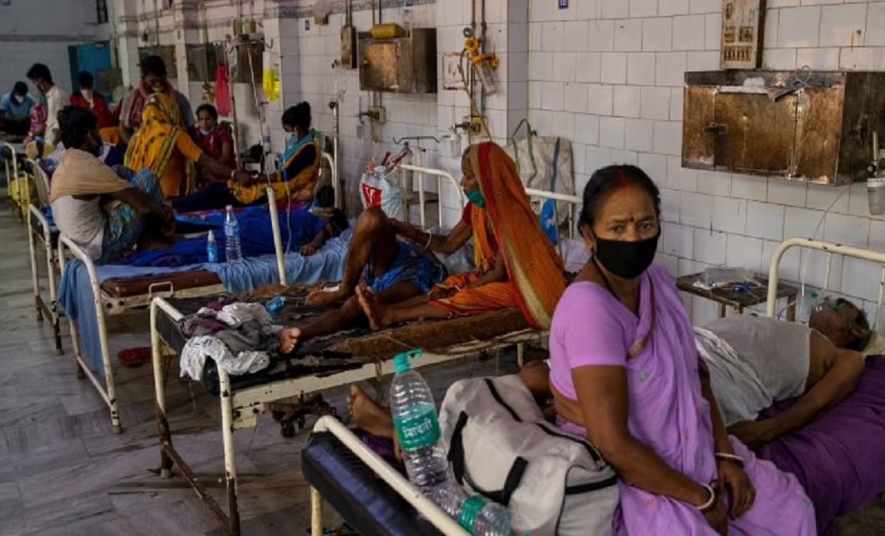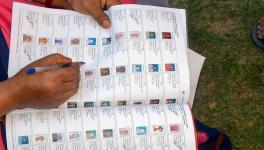Bihar’s Apathy: Dilapidated Healthcare System Fails During Pandemic

Raipura Mahadeo is a village with a small bazar near the Gandak river in the Saraiya-Paroo area of western Muzaffarpur in Bihar. It is backward on all indices of development and progress. A part of the Vaishali Lok Sabha, its bazar caters to the people of seven or eight nearby panchayats. It is 50 kilometres from the district headquarters and at least as far from the adjacent towns of Hajipur in Vaishali and Chapra in Saran.
In the 1980s, Raipura Bazar got a 25-bed government referral hospital. Another referral hospital came up in nearby Sarmastpur village in Paroo, also of 25 beds. There are no facilities at either hospital. The doctors left long back, within a few years after they opened. The hospitals look deserted. Sarmastpur, which is in the Sahebganj Assembly of Muzaffarpur, was represented many times by Ramvichar Rai, a former minister in the Bihar Cabinet who died of Covid-19 earlier this month. There is yet another referral hospital at the headquarters of the Community Development Block in Saraiya, long-abandoned too. It has the appearance of a phantom house in a forest
Almost every day, people are succumbing to Covid-19 in these villages. The most prominent cremation site in the area is Rewa Ghat. According to locals, at least six to seven times more people are being cremated here these days than before April. Earlier, the daily average of cremations was ten to twelve, now the figure is above sixty or seventy. This does not include other smaller cremation spots along the Gandak in this area. Across the Rewa Ghat is Amnour in Saran, the native village of the BJP parliamentarian and former minister Rajiv Pratap Rudy, which was in the news recently for the so-called ambulance scam exposed by former strongman-parliamentarian Rajiv Ranjan aka Pappu Yadav.
However, neither the Muzaffarpur editions of vernacular dailies nor the surviving kin of the dead claim that Covid-19 infections responsible for these deaths. For example, a popular Hindi daily that tenaciously protects the regime’s image did not stop doing so even during the second wave. News reports and interviews, nonetheless, invariably admit that most of the deceased had a cough, cold, fever and breathlessness (hanphni)—all are well-known symptoms of Covid-19. These days, most people find out about deaths, even in their family, only after the final rites. One reason is the inhibition among rural families to reveal that they may have a Covid-19 patient in their village or home. They prefer to suppress this information for fear of being stigmatised. They worry that other resident will distance themselves from families with suspected infected. It is contributing to the lack of information on Covid-19 fatalities and total caseload.
Sushasan Era in Bihar and Uttar Pradesh
Since the eighties, many kinds of regimes have governed Bihar and all mastered lofty rhetoric: the social justice and “garibon ka maseeha” era of Lalu-Rabri, the sushasan (good governance), Vikas (inclusive development), and dawaayee-parhayee-kamaayee (healthcare, education, employment) era of Nitish Kumar, who is now in alliance with the “party with a difference”, the BJP. None took care of rural government hospitals. Their derelict condition speaks for the commitment of each regime for the poor and backward of Bihar.
The bitter irony is that when, a few years ago, a controversy broke out around the Bollywood film Padmavat, some residents of the villages around Raipura Bazar and Sarmastpur felt outraged enough to raise units of the Karni Sena to protect their caste honour. A Hindu Yuva Vahini unit is also operational in the area. Its counterpart in the district town of Muzaffarpur vandalised a cinema hall that screened the film. Of course, no caste or community agitates for better infrastructure or improvements in government hospitals. Instead, over the last few years, one would hear chatter about the “Gujarat model of development”. People spoke of the merits of this model, while news of the Kerala model of public healthcare and other state-led welfare measures in the southern provinces seemed not to have reached them.
Despite the self-destructive apathy of the state and society, a few months ago, the building of the hospital at Raipura was renovated. The boundary wall got rebuilt. Yet, not one doctor got posted at this hospital, no beds were arranged, and there is no oxygen supply either. The wretched hospital was waiting to be inaugurated by the local MLA (it is his fourth consecutive electoral victory) and other bigwigs of the NDA government. In the meantime, the pandemic revisited this region with the furious second wave, and so the proposed spectacular celebration of state benevolence and welfarism stands postponed.
Not just Covid-19, every year since the mid-1990s during the season of litchi harvesting (in May), Muzaffarpur reports child deaths due to an encephalitis-like disease that locals call chamki fever. No doctor was appointed to take care of even such regular patients. In terms of infrastructure, the two referral hospitals at Raipura Bazar and Sarmastpur are visibly worse off than even the makeshift “hospitals” that panchayats are now erecting to offer a semblance of health care to the Covid-19 patients. Many of these mukhiyas (elected panchayat chiefs) and mukhiya-patis (husbands of women mukhiyas who rule on their behalf) are involved, even incarcerated, in criminal cases. Their tenures have been tentatively extended as the elections due last April are on hold due to the pandemic. Therefore, the area is getting cosmetic improvements in healthcare facilities, but the goal appears to be to give the local emperors an image makeover.
The incumbent Chief Minister of Bihar Nitish Kumar invokes his antaratma (conscience) all the time, but the dead bodies floating in the Ganga at Buxar expose the social and moral degradation that prevails. These deaths are more a result of the wilful unpreparedness of governments than anybody is ready to acknowledge. For sure, the ruin of public healthcare no longer shakes the conscience of the government in Bihar. Remember that Buxar, which is adjacent to Ballia and Ghazipur in eastern Uttar Pradesh, is represented in the Lok Sabha by Union Cabinet Minister Ashwini Chaubey of Bhagalpur. In early 2018, a series of violent communal incidents had unrolled across Bihar starting from Bhagalpur, and Arijit Saraswat (Chaubey is his father), was seen as an agent provocateur.
A recent Bihar government affidavit submitted to the Patna High Court displays a ridiculous level of inconsistency in the number of deaths due to Covid-19. It also acknowledges a lower death toll than sections of the media report, based on ground reports.
However, Uttar Pradesh seems no different than Bihar in this respect. Combine the underestimation in Bihar with the bodies, allegedly of Covid-19 victims, that floated down the Ganga and Yamuna from Uttar Pradesh and those discovered buried in dunes along these rivers in Varanasi, Prayagraj and elsewhere. While the media was raising the concern that these deaths were Covid related, the Chief Minister of Uttar Pradesh Yogi Adityanath visited the western parts of Uttar Pradesh near Delhi with much fanfare. Many speculate that Adityanath’s “de-tour” was only an attempt to divert people and the media from the gory reality unfolding on the other end of the state.
Building tolerance for anti-science
Horrific pandemic tales follow us around, coming from the most remote and interior villages of Bihar to the big district towns and Patna, the capital city. Nevertheless, it is the rural areas where the suffering is more intense on account of a persistent neglect of healthcare. They expose us as a society and reveal the poor quality and character of our state and governance. Sadly, these deficits permeate the Opposition in Bihar as well. Tejashwi Yadav of the RJD swung into action to help Covid-19 patients only after Pappu Yadav hogged the limelight on the ambulance issue. Nevertheless, it is a welcome development—better late than never!
To conceal the havoc caused by the pandemic, the ruling regimes and their collaborators and apologists are attempting to mislead the “innocent” people with dangerous statements. The claim that the invisible killer coronavirus can be eliminated through consuming cow urine, cow dung, dark chocolate, and sundry herbs, is part of this effort to conceal reality. The Constitution talks of inculcating the scientific temperament. Still, there is high social tolerance for anti-science, even when it imperils health on a mass scale, mostly because the state has abdicated the responsibility to educate and provide healthcare for all.
In the name of healthcare, the government provides non-functional referral hospitals of the sort we see at Raipura Bazar and Sarmastpur. The withering away and apathy of the state creates an even deadlier cocktail when outfits complicit with the ruling regime shamelessly peddle animal faeces as “medicine”.
So, are we prepared to learn the right lessons from the carnage wreaked by this epidemic? Will we prioritise public healthcare and education and employment-creation over subscribing to and propagating hate-filled ideologies and irrationality? Will the people of Raipura Bazar and around agitate for hospitals and schools, communication and energy, employment and justice delivery? Or will they squander their energy to raise more Karni Senas and Yuva Vahinis? The answers will decide the future of India. For too long people have accepted as a truism that India lives and dies in its villages.
The author teaches modern and contemporary Indian history at Aligarh Muslim University. The views are personal.
Get the latest reports & analysis with people's perspective on Protests, movements & deep analytical videos, discussions of the current affairs in your Telegram app. Subscribe to NewsClick's Telegram channel & get Real-Time updates on stories, as they get published on our website.
























